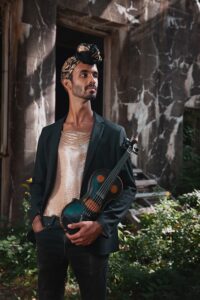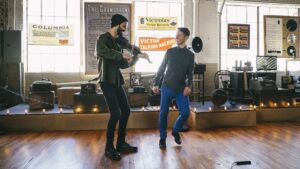Nic Gareiss turned 11 on the same day that he first laid eyes on his “dancestor” Liam Harney, two-time world champion Irish step dancer, performing solo at the 1997 Wheatland Music Festival in Remus, Mich. The festival was near Gareiss’s hometown of Lansing — he watched with his parents in a crowd of 12,000.

“In that moment, I had these two simultaneous libidinal revelations,” says Gareiss. “The first was: ‘I really want to do what that person is doing; I want to become the Irish dancer.’ I was also like, ‘Wow, I feel some kind of attraction to that human.’ ”
“Dancestry,” Gareiss says, is a term that comes from the percussive dancer, scholar, and writer Janet Schroeder: a word to describe the bodily memory that connects dancers across generations as each learns from those who came before.
Harney was a “double punch of revelation,” says Gareiss. That moment, he says, “was the beginning of both my queerness and my path as a professional folk dancer.”
He will be dancing on Saturday, Nov. 23 at Thacher Hall in Yarmouth Port in a trio with Jake Blount on fiddle and banjo and Sammy Wetstein on cello, both of whom are also queer. Gareiss met Blount and Wetstein more than 10 years ago, he says, through the broader folk and fiddle music scene.
“The performance will feel like three queer folks trying to figure out how to best seek pleasure together,” says Gareiss, “using both instruments and our bodies.”
Gareiss is a percussive dancer: his movements are inseparable from their sounds. “It takes movement to make sound,” he says. “I’m interested in questioning the space between those senses, between what you can see and what you can hear.” His dancing is about touch, he says. “It’s about the haptic connection with the ground.” He draws from a range of percussive dance practices: Irish step dancing, Afro-diasporic dance traditions, Appalachian flatfooting, and tap dance.
Unlike in ballet, where the dancers leap and land as silently as they can, Gareiss uses his feet to strike and scrape the floor. His toes rap with precision; his heels drum a heavier beat.
“My favorite sounds to make as a dancer are those that come out of sustained contact with the floor,” says Gareiss. “It’s almost like I’m bowing the floor.” Gareiss uses other words, too: brushing, stroking, tracing, caressing. His movement is sensitive, nuanced; his feet coax music from the ground.
“I had a teacher who forbade us from scraping in class,” says Gareiss. “Her idea of good technique was that it was short and sharp. I think there’s a delicious queer pleasure in doing what you’re told not to do.”
Often, says Gareiss, Irish dancers, when performing with musicians, will stand in front of the band. Gareiss doesn’t perform that way anymore. He says the lack of eye contact and connection between dancer and musician no longer felt satisfying. Now he stands beside his companions on the stage. When all the performers are on the same plane, he says, “there’s a lot more choice and agency. The rhythms pass back and forth in a kind of dialogue.”
He wears leather-soled shoes when performing with acoustic musicians, he says — a change from the tap shoes he used to wear. In leather, “I can be very brushy and sibilant,” he says. “I can also put my energy through and contact the floor if I want to make a louder or deeper sound. The leather expands the sonic palette, the colors that I can produce on the floor.”

Blount and Wetstein won’t be dancing, but Gareiss says, “The great thing about this trio is that both Jake and Sammy are really nice movers.” Wetstein often stands when he plays the cello. Blount, fiddle on their shoulder, dips and bounces with the constant rhythmic music. The bow arms of the musicians push and tug in an insistent conversation with Gareiss’s feet.
Gareiss says he likes to think of his musician collaborators with their instruments as a single body: the instrument as an extension, a prosthesis. “They’re like dancers who are holding things,” he says.
The concert will be a kind of “blurring and meshing,” says Gareiss, “of music for the eyes, if you will, and dance for the ears.”
Gareiss, who was one of Dance Magazine’s “25 to Watch” in 2019 — actually, they called him “not just one to watch, but one to hear” — has performed in 16 countries. He’s traveled to Ireland and Scotland to learn and teach. In 2009, he co-founded Earful of Fiddle Music & Dance Camp, a summer program that brings nationally known professional folk artists to teach and perform in rural Michigan.
In 2020, Gareiss received a Michigan Heritage Award, which his website calls “the highest honor bestowed on traditional artists in Michigan.”
He has a master’s degree in ethnochoreology — “ethnomusicology for dancing” — from the University of Limerick in Ireland. He did anthropological field work there and conducted interviews in which he spoke to other queer Irish step-dancers about their experiences in the world of percussive dance.
“They’d tell me stories, talk about their teachers,” he says. Some felt they had to change the way they moved or looked in competition, says Gareiss. Some felt empowered and affirmed by the form. “Mine wound up being the first thesis ever published that specifically worked with queer step-dancers.”
Gareiss is almost certainly someone’s dancestor, as Harney was his.
Blount’s music, too, has to do with memory. “The repertoire for the concert,” says Gareiss, “is drawn from Jake’s deep research into Black and Indigenous fiddle and banjo music from the American southeast,” especially the Tidewater region of Virginia, where their ancestors are from. The trio is trying to create “a soundscape that helps to re-enliven that music.”
The music never died, Gareiss adds. “But the contributions of Black and Indigenous players have been written out of the story a lot of times,” he says. “Jake is at the forefront of trying to bring that back into people’s consciousness.”
Blount, Wetstein, and Gareiss are all interested in that history, sidelined “because of various forces: homophobia, transphobia, white supremacy, nationalism,” says Gareiss. “Our very presence onstage as three queer people reinserts ourselves into the history.”
It’s a reparative project, he says, and a personal one.
The energy onstage will be focused, says Gareiss. But he says the performance will also be distinctly playful. “It’ll feel like a late-night jam session,” he says. “This trio is celebratory. There’s a kind of eros around listening to each other. We’re trying to hold this particular rhythmic groove around a melody and let the audience members witness that and feel it in their own bodies, too.”
Fiddling Around
The event: Nic Gareiss, Jake Blount, and Sammy Wetstein in concert
The time: Saturday, Nov. 23, 7 p.m.
The place: Thacher Hall, 266 Main St., Route 6A, Yarmouth Port
The cost: $35-$40 at tickets.payomet.org



